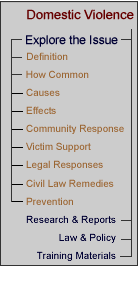|
|
|
LETHALITY ASSESSMENTS A number of factors have been associated with an increased risk of lethal violence. For example, when a man is excessively jealous and constantly wants to know where his partner is, he should be considered dangerous. A jealous batterer often tries to control his wife or partner’s behavior and may accuse her of having affairs. These men often “stalk” women when they leave the relationship or move out of the house. Often when a batterer kills his wife or partner, he has threatened homicide or suicide in the past. These threats should be taken very seriously. Batterers who are heavy drug and alcohol abusers are more likely to kill. The abuse of alcohol and drugs has also been found to be a factor in cases where women kill their batterers. Often, women are more afraid when men use drugs and alcohol and are more likely to use violence to protect themselves during an assault. Research indicates that the most dangerous time for a battered woman is after she ends the relationship. In the United States, research indicates that women who leave their batterers are at a 75% greater risk of being killed by their batterers than those who stay. From Julian Center, Women in the US; Casa de Esperanza, Myths and Facts. It is very important for a battered woman to make her own decision to leave a relationship because she is in the best position to assess the potential danger. An abuser’s prior “choking” or “strangling” of the victim as an indicator of extreme danger. When a batterer is extremely depressed and appears to lose hope for moving beyond the depression, he may be more likely to commit homicide and/or suicide. When a batterer possesses weapons or there are weapons or dangerous objects around the house, the batterer is more likely to use them in an assault. A batterer who has used weapons in previous abusive incidents or made prior threats with weapons may be more likely to use weapons again. Studies also indicate that the isolation of the batterer and the extent to which he is dependent on the battered woman correlate with the use of lethal violence. Escalation of the violence in frequency or severity can also indicate increased dangerousness. Some men who batter believe that their wives or partners belong to them. A batterer who believes he is absolutely entitled to his female partner, her services, her obedience and her loyalty is likely to be life endangering. Neil Websdale, Lethality Assessment Tools: A Critical Analysis, offers an excellent overview of the current state of research on lethality or dangerousness, describes some of the problems that arise this research, and details the ways in which lethality assessment tools can be used to educate the public, raise the awareness of service providers, and provide battered women with an additional lens through which to evaluate their options and plan for their safety. Sample lethality assessment tools are provided by the U.S.-based Domestic Violence Institute and Alabama Coalition Against Domestic Violence. |

